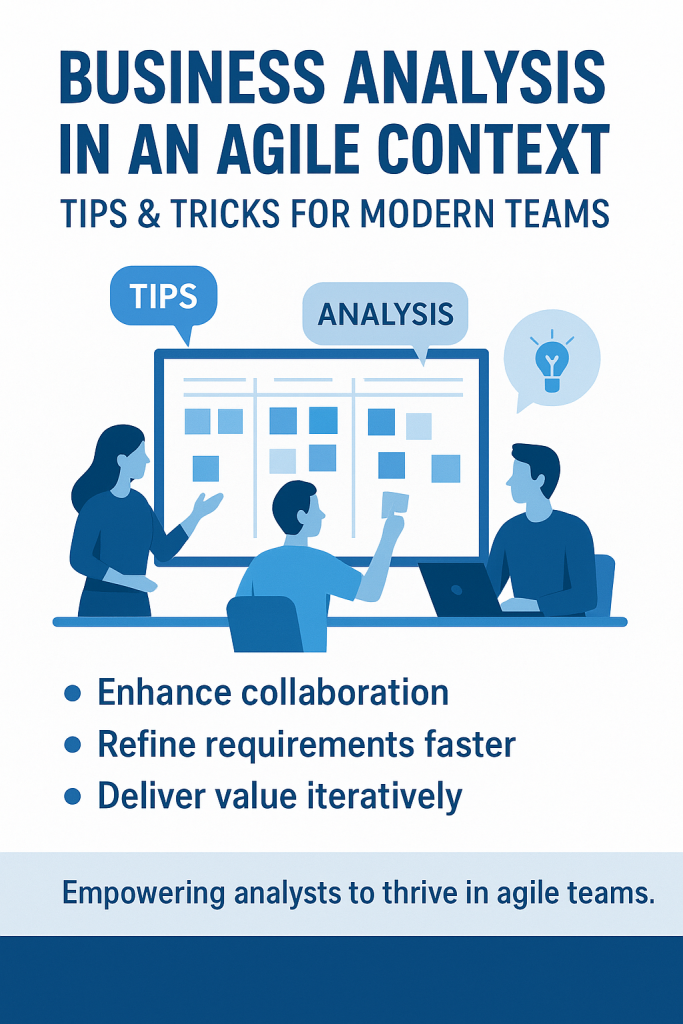The world of business is changing fast. Organizations are moving away from rigid, traditional models and embracing Agile frameworks that prioritize flexibility, collaboration, and continuous improvement.
In this environment, Business Analysts (BAs) are no longer just requirement gatherers — they’ve become strategic partners in delivering value. But what does business analysis look like in an Agile context? How can analysts thrive in this fast-moving world?
Let’s explore what makes Agile business analysis different and how you can excel using proven tips and techniques.
- Understand the Shift From Documents to Dialogue
In traditional projects, business analysis was often about documentation — requirements lists, functional specs, and sign-offs. But in an Agile team, the focus shifts from documentation to communication and collaboration.
Business Analysts now work closely with Product Owners, Scrum Masters, and development teams to ensure that every sprint delivers meaningful outcomes.
Tip: Instead of aiming for “perfect” documentation, focus on clarity and alignment. Ask: “Does everyone on the team understand what success looks like for this story or sprint?”
In Agile teams, business analysts act as value translators connecting customer needs to technical execution. They bridge the gap between what stakeholders want and what developers build.
To thrive in this environment, BAs must learn to think in terms of value delivery rather than feature completion. Each user story, each sprint goal, and each deliverable must tie back to the larger business objectives and OKRs (Objectives and Key Results).
Trick: When writing user stories, always ask “why.”
“As a user, I want [feature], so that [benefit].”
That “so that” part is where the business value lives.
- Collaborate Deeply with the Scrum Team
In an Agile setup particularly within Scrum collaboration is everything. A successful BA doesn’t work in isolation but as part of the cross-functional Scrum team.
Tip: Use backlog refinement sessions as opportunities to align everyone on business goals. Don’t just discuss “what” needs to be built explore “why” it matters and “how” success will be measured.
This makes the BA a key enabler of transparency and shared understanding — two pillars of Agile success.
- Prioritize Incremental Learning and Feedback
In Agile environments, change is constant. Business Analysts must be comfortable adapting to new information, customer feedback, or shifting priorities.
That’s why continuous learning is crucial. The most effective analysts are those who are curious — they learn not only about Agile practices but also about the products, customers, and industries they serve.
Trick: After every sprint, reflect on what insights you gained — both from the process and the outcomes. Use retrospectives not just for the team, but for yourself as a professional growth opportunity.
Tools like JIRA, Confluence, and Miro can also help analysts visualize progress, track insights, and communicate complex requirements more clearly.
- Develop Power Skills Not Just Technical Skills
While technical knowledge is essential, success in Agile business analysis depends just as much on soft skills — or what we now call power skills.
These include:
Emotional intelligence (to manage team dynamics and stakeholder expectations)
Strategic thinking (to align user needs with business outcomes)
Effective communication (to simplify complex requirements)
Facilitation and negotiation (to balance competing priorities)
Tip: Strong BAs are great storytellers. They translate technical insights into clear narratives that stakeholders can understand and act on.
At Scrum Consult, we help professionals build these exact skills. Through our Business Analysis & Agile programs, learners don’t just understand frameworks they learn how to apply them effectively in real-world projects.
- Stay Grounded in Agile Principles
Finally, remember: business analysis in Agile isn’t about abandoning structure — it’s about finding the right level of structure for the context.
Always circle back to the Agile Manifesto:
“Individuals and interactions over processes and tools.”
“Responding to change over following a plan.”
Trick: Use Agile principles as your compass. When in doubt, ask yourself — “Does this action help the team deliver value faster and better?”
That mindset alone will set you apart as a business analyst who thrives in Agile environments.
Conclusion: Adaptability Is the New Edge
The modern business analyst is no longer confined to requirement documents. They’re strategic thinkers, collaborators, and change enablers working within Agile teams to create products and services that truly deliver value.
If you’re ready to evolve in this direction, Scrum Consult’s Business Analysis and Agile programs are designed to help you develop the skills, confidence, and certification you need to stay relevant in today’s market.
Whether you’re new to Agile or looking to deepen your experience, we’ll guide you to become a confident, adaptive, and industry-ready business analyst.
Your next level begins here — visit Scrum Consult today to start your Agile journey.
Keywords:
Business Analysis, Agile Framework, Scrum, Product Owner, Business Analyst Skills, Agile Project Management, Continuous Improvement, Value Delivery, Backlog Refinement, Power Skills, OKRs, Scrum Consult

